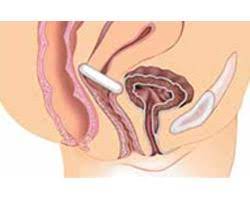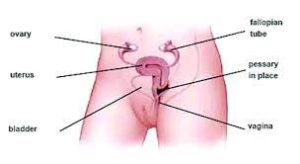
 A pessary is a prosthetic device inserted into the vagina for structural and pharmaceutical purposes.
A pessary is a prosthetic device inserted into the vagina for structural and pharmaceutical purposes.
It is commonly used to treat stress urinary incontinence to stop urinary leakage and to treat pelvic organ prolapse.
It seeks to maintain the location of organs in the pelvic region.
It can also be used to administer medications locally in the vagina or as a method of contraception.
Individuals should be fitted for them by health care professionals.
The most common use for pessaries is to treat pelvic organ prolapse.
Pelvic organ prolapse occurs when the muscles and tissues surrounding the bladder, uterus, vagina, small bowel, and rectum do not hold the organs in place and the organs begin to drop outside the body.
The most common cause of such prolapse is childbirth, usually multiple.
Obesity, long-term respiratory problems, constipation, pelvic organ cancers, and hysterectomies are additional causes for pelvic organ prolapses.
Pelvic organ prolapse signs and symptoms include feeling pressure in the pelvic area, lower back pain, painful intercourse, urinary incontinence, constipation, or bleeding from the vagina.
Pessaries inserted into the vagina to help support and reposition descended pelvic organs, prevents the worsening of prolapse, symptom relief, and can delay or prevent the need for surgery.
They can be used prior to surgery to maintain prolapse without progression.
Pessaries are considered a non-surgical treatment option for stress urinary incontinence as it can control the urine leakage by pushing the urethra closed.
Pessaries can be used to correctly position the cervix, increasing the success of pregnancy.
Therapeutic pessaries support the uterus, vagina, bladder, or rectum, and are most commonly used for pelvic organ prolapse and considered a good treatment option for women who need or desire non-surgical management or future pregnancy.
It is used to treat prolapse of uterine, vaginal wall, bladder (cystocele), rectum (rectocele), or small bowel (enterocele), and stress urinary incontinence.
Most pessaries are made out of silicone.
Pessaries are categorized into two types: supporting and space-occupying.
Support pessaries support the prolapse and space-occupying pessaries by filling the vaginal space.
They are often used as a first-line treatment and used for earlier stage prolapse since patients can easily insert and remove them on their own.
without a doctor’s help.
Some pessaries are considered a type of supporting and space-occupying pessary.
They resemble the shape of a mushroom and are used for more advanced pelvic organ prolapse.
Supporting and space-occupying pessaries are less preferred than ring with support pessary due to difficulty with self-removal and insertion.
Marland pessaries have a ring at their base and a wedge-shaped ridge on one side, and are used to treat pelvic organ prolapse as well as stress urinary incontinence.
Marland pessaries are less likely to fall out than standard ring with support pessaries, but are difficult to insert or remove them on their own.
Donut space-occupying pessaries are used for more advanced pelvic organ prolapse including cystocele or rectocele as well as a second or third-degree uterine prolapse.
Donut space-occupying pessaries
are hardest ones to insert and remove.
Cubed shaped pessaries are space-occupying pessaries inserted into the vagina and kept in place by the suction of its 6 surfaces to the vaginal wall.
Cube pessaries are removed before sexual intercourse and replaced daily.
Cube pessaries are used as a last resort only if the individuals cannot retain any other pessaries, due to undesirable side effects such as vaginal discharge and erosion of the vaginal wall.
Gehrung pessaries are silicone device that are placed into the vagina and used for second or third degree uterine prolapse.
They can also be used to help with stress urinary incontinence such as urine leaks during exercising or coughing.
Vaginal yeast infections are one of the most common uses for pharmaceutical pessaries: vaginal suppositories, which are inserted into the vagina and are designed to dissolve at body temperature,and usually contain a single use antifungal agent such as clotrimazole.
Pessaries can help induce labor for women who have overdue expected delivery dates or who experience premature rupture of membranes.
Prostaglandins are usually used in these kinds of pessaries in order to relax the cervix and promote contractions.
Occlusive pessaries are most commonly used for contraception.
Occlusive pessaries are inserted into the vagina and blocks sperm from entering to the uterus through the cervix.
The cap must be used in conjunction with a spermicide in order to be effective in preventing pregnancy.
When used correctly the cap is thought to be 92–96% effective.
Lubricating pessaries, improve vaginal dryness during sexual intercourse.
It consists of a solid block of lubricating gel which slowly melts when inserted into the vagina, and may be inserted well before intercourse to improve spontaneity.
Pessaries are tolerated well for pelvic organ prolapse or stress urinary incontinence.
Some more common side effects include vaginal discharge and odor.
Vaginal discharge and odor may be associated with bacterial vaginosis.
More serious side effects include: fistula formation between the vagina and rectum or the vagina and bladder, or erosion, or thinning, of the vaginal wall.
Low estrogen production can also increase the risk of vaginal wall thinning.
In ill-fitted pessaries herniations of the cervix and uterus can occur through the opening of the pessary, leading to tissue necrosis in the cervix and uterus.
In patients with an increased risk of vaginal wall thinning, can be prescribed estrogen can prevent erosion and prevent complications.
Improper or not maintained pessaries may lead to serious complications: pessary can become embedded into the vagina, and rarely would need to be removed through surgical procedures.
Contraindications to pessary use:
current infections in the pelvis or vagina
allergies to the material of the pessary
Risk of individuals not likely to properly maintain their pessary.
